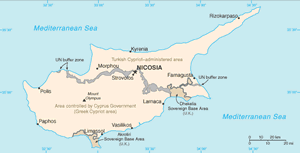The Geography of Cyprus
The Geography of Cyprus
Cypriot Geography
Location: Middle East, island in the Mediterranean Sea, south of Turkey
Geographic coordinates: 35 00 N, 33 00 E
Map references: Middle East
Area: total: 9,250 sq km (of which 3,355 sq km are in north Cyprus) land: 9,240 sq km water: 10 sq km
Area - comparative: about 0.6 times the size of Connecticut
Land boundaries: total: 150.4 km (approximately) border sovereign base areas: Akrotiri 47.4 km, Dhekelia 103 km (approximately)
Coastline: 648 km
Maritime claims: territorial sea: 12 nm contiguous zone: 24 nm continental shelf: 200 m depth or to the depth of exploitation
Climate: temperate; Mediterranean with hot, dry summers and cool winters
Terrain: central plain with mountains to north and south; scattered but significant plains along southern coast
Elevation extremes: lowest point: Mediterranean Sea 0 m highest point: Mount Olympus 1,951 m
Natural resources: copper, pyrites, asbestos, gypsum, timber, salt, marble, clay earth pigment
Land use: arable land: 10.81% permanent crops: 4.32% other: 84.87% (2005)
Irrigated land: 400 sq km (2003)
Natural hazards: moderate earthquake activity; droughts
Environment - current issues: water resource problems (no natural reservoir catchments, seasonal disparity in rainfall, sea water intrusion to island's largest aquifer, increased salination in the north); water pollution from sewage and industrial wastes; coastal degradation; loss of wildlife habitats from urbanization
Environment - international agreements: party to: Air Pollution, Air Pollution-Nitrogen Oxides, Air Pollution-Persistent Organic Pollutants, Air Pollution-Sulfur 94, Biodiversity, Climate Change, Climate Change-Kyoto Protocol, Desertification, Endangered Species, Environmental Modification, Hazardous Wastes, Law of the Sea, Marine Dumping, Ozone Layer Protection, Ship Pollution, Wetlands signed, but not ratified: none of the selected agreements
Geography - note: the third largest island in the Mediterranean Sea (after Sicily and Sardinia)


